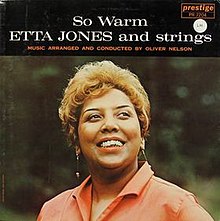Renaissance woman of sorts—a world class chef (her culinary skills were documented in the Washington Star), a formidable painter, social activist, and composer, even penning blues numbers like “One Sided Love Affair” and “I’ve Found My Peace of Mind” for famed guitarist Pee Wee Crayton.Bradford, of Choctaw-Cherokee-Ethiopian descent, was the daughter of a minister whose parish was in rural southeastern Missouri, but when she was seven, her parents separated and she moved with her mother to St. Louis. She'd been exposed to church music at home, and had loved to sing it, but St. Louis opened up a new door for her. That door was next door, and her next door neighbor in the Gateway City was Jimmy Forrest.
Forrest's house was more or less an ongoing jam session, and when Clea ventured next door, she was likely to meet other young St. Louisans like Oliver Nelson and Miles Davis. Or Clark Terry, down on a pass from Great Lakes Naval Base. And gradually, as a young teenager, she began to join in. By 17, she was a part of the St. Louis club circuit, and then, hearing that there were more musical opportunities, she moved to Detroit--a great apprenticeship for any young musician. She made her first recording, a 45 RPM rhythm and blues single, for Detroit's Hi-Q label.
Then on to New York, and a reunion with old friend Oliver Nelson, who got her a recording date with Prestige. and brought Clark Terry along to play on the gig, a collection of standards. It's a curious record, in that neither Nelson or Terry does a lot on it. It is musically interesting, because Bradford is a good singer, but mostly because of the piano work of newcomer Patti Bown.
Bown was 29 at the time of the session. She had made a record for Columbia in 1958. This was her second recording session, and her first for Prestige. She would go on to be very much in demand throughout the decade, frequently on Bob Weinstock's label. Like Clea Bradford with Oliver Nelson, Bown was able reconnect in New York with an old friend from childhood, who would hire her for his big band and connect her to others. In her case, it was Quincy Jones.
Bradford reportedly was not satisfied with her performance on the album, which I guess is one of the problems with being a perfectionist. She actually sounds quite good. There's a debt to Dinah Washington, but that's hard to avoid for a young jazz and rhythm and blues singer coming up in the 1950s. But in later interviews, she never spoke of it. But the dissatisfaction appears to have been just with herself, not with Oliver Nelson. She remained close friends with him, and they would work together years later in Los Angeles.
The album was released on Tru-Sound as These Dues, that being one of the two new songs from the session. I think a Bradford original; I'm not sure. Tru-Sound being Prestige's pop and "modern rhythm and blues" label, most of their recording sessions yielded at least one single, and "These Dues" would have been the logical choice, but no single was released, so maybe Weinstock wasn't excited enough with the results either. It would later be rereleased on New Jazz as Clea Bradford with Oliver Nelson and Clark Terry.
There would be one more jazz record for a New York label, Mainstream (Clark Terry was involved in that session too), and then at the end of the decade, a session for Cadet, a subsidiary of Chicago's Chess Records, By that time, she had become a mainstay of the various Playboy Clubs, a door opened for her by another old friend from St. Louis, comedian Dick Gregory. The Playboy Clubs, a very hot franchise in the 1960s, did not cater to a musically sophisticated audience but did feature top jazz names. Bradford had worked with, and become friendly with Kenny Burrell, who was on Cadet at the time.
Her album for Cadet was called Her Point of View. It was essentially a soul album, and its single, "My Love's a Monster," got good air play, and might have been a hit. Might have been, but it turned out that while Bradford may not have been satisfied with her performance on the Prestige album, the musical selections represented what she wanted to sing. On the strength of "My Love's a Monster," she got booked for soul reviews...where she refused to sing "My Love's a Monster," instead delivering jazz standards to a dissatisfied audience.
She continued to tour and sing through the 1970s and 1980s, then coming in off the road, she took a degree at Jerry Falwell's Liberty University, and became a minister. Also in these years, she grew more in touch with her Native American heritage, changing her name to Clea Bradford-Silverlight.





:format(jpeg):mode_rgb():quality(40)/discogs-images/R-4720056-1447471969-8263.jpeg.jpg)






:format(jpeg):mode_rgb():quality(90)/discogs-images/R-2884782-1305631390.jpeg.jpg)




:format(jpeg):mode_rgb():quality(90)/discogs-images/R-4219801-1482257390-1358.jpeg.jpg)

:format(jpeg):mode_rgb():quality(40)/discogs-images/R-11390588-1515458714-9611.jpeg.jpg)





:format(jpeg):mode_rgb():quality(40)/discogs-images/R-8969957-1478838084-9370.jpeg.jpg)
